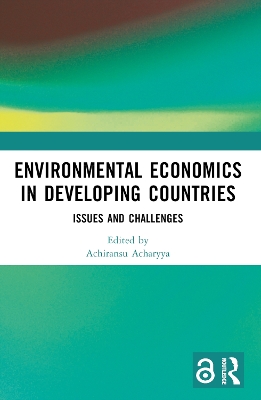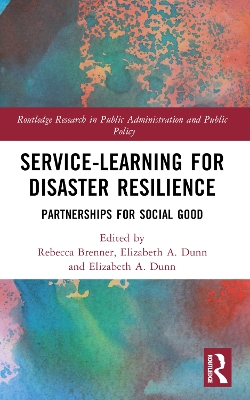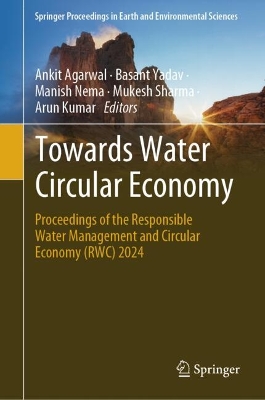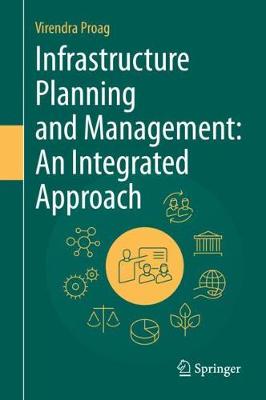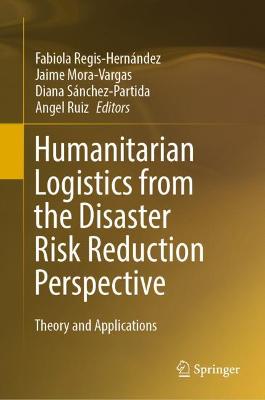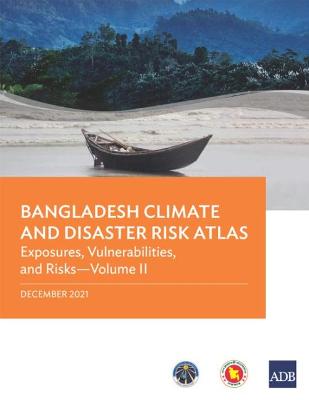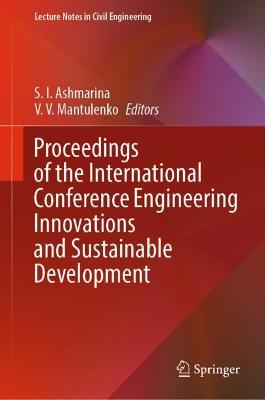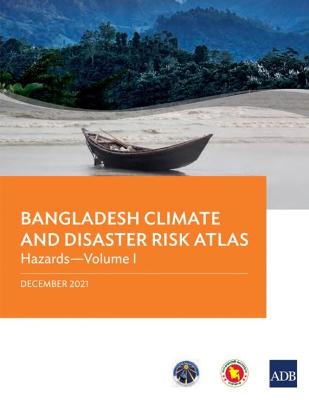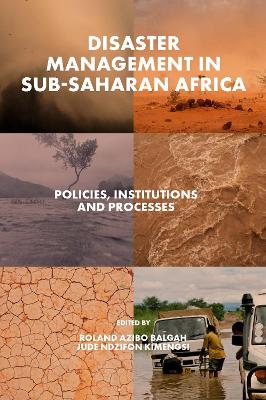Infrastructure Planning and Management: An Integrated Approach
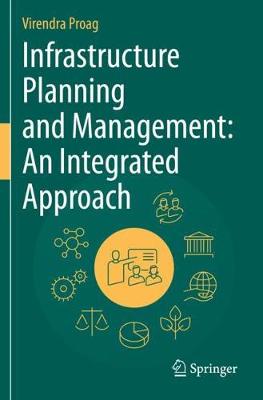 portes grátis
portes grátis
Infrastructure Planning and Management: An Integrated Approach
Proag, Virendra
Springer Nature Switzerland AG
11/2021
683
Mole
Inglês
9783030485610
15 a 20 dias
1263
Chapter 1: INTRODUCTION TO INFRASTRUCTURE
1.1 Infrastructure
1.2 Examples of Infrastructure
1.3 Services
1.4 Why Do We Need Infrastructure?
Chapter 2: INFRASTRUCTURE AND ECONOMIC GROWTH
2.1 Introduction 2.2 Economics Applicable to Infrastructure 2.3 The Process of Production 2.4 Impact of Infrastructure on Economic Development
2.5 Infrastructure's Effects on Economic Development
2.6 Infrastructure and Macroeconomic Stabilization
2.7 Implications for Infrastructure Policy and Planning
2.8 Conclusion
Chapter 3: INFRASTRUCTURE VISION FOR SD
3.1 Objectives of Development
3.2 Sustainable Development
3.3 Sustainable Development Goals (SDG)
3.4 Using Infrastructure to Achieve SDG
Chapter 4: INFRASTRUCTURE AND SPATIAL ORGANISATION
4.1 Cities for People
4.2 Low or High Density
4.3 Green Urbanism Principles
4.4 Smart and Sustainable Cities
4.5 Infrastructure According to Spatial Organisation
4.6 Conclusion
Chapter 5: INFRASTRUCTURE AS A SYSTEM
5.1 Interactions between Water and other Sectors
5.2 Interactions among Infrastructure Sectors
5.3 Systems Analysis for Infrastructure Sectors
5.4 Applying Systems Analysis to Infrastructure
5.5 Elements of System Dynamics Modelling
5.6 Modelling Principles
Chapter 6: THE LONG TERM PLAN FOR INFRASTRUCTURE
6.1 Introduction
6.2 Planning Investment in The Water Sector
6.3 Basic Activities Required
6.4 Planning the Activities
6.5 Establishing the Time Frame
6.6 Action Plan for Safeguarding Infrastructure Availability
6.7 The Decision Making Process
6.8 Conclusion
Part II Planning Objectives and Modeling
Chapter 7: ECONOMIC AND SOCIAL ASPECTS OF INFRASTRUCTURE
7.1 Welfare Economics
7.2 The Benefit-Cost Viewpoint
7.3 The Allocation of Incommensurable Resources for Incommensurable Goods
7.4 Social Welfare Functions
7.5 Designing Measures of Effectiveness: Public Health
7.6 Allocation of a Scarce Resource Space for Cars
7.7 Energy Policy Challenges
Chapter 8: INFRASTRUCTURE AS PUBLIC OR PRIVATE GOODS
8.1 The Different Kinds of Goods
8.2 Public Goods
8.3. Capital Goods
8.4 Social Goods
8.5 Social Goods and Externalities
8.6 Societal Demand for Infrastructure
8.7 Commercial, Public and Social Infrastructure
Chapter 9: MULTI SECTOR/PURPOSE INFRASTRUCTURE PLANNING
9.1 Introduction 9.2 Descriptive Models of the Planning Process 9.3 Planning Strategies 9.4 Infrastructure Planning Objectives 9.5 Trade-Offs and Political Feasibility 9.6 Formulation of Planning Alternatives 9.7 Plan Selection: The Identification of Politically Feasible Alternatives 9.8 Summary
Chapter 10: CLIMATE CHANGE AND INFRASTRUCTURE
10.1 Introduction
10.2 Climate Change Variables
10.3 Preparing a Climate Resilient Infrastructure
10.4. Approaches and Mechanisms to Support Climate Resiliency
10.5 Barriers
10.6 Conclusion
Chapter 11: INFRASTRUCTURE RESILIENCE
11.1 Resilience
11.2 Assessing Infrastructure Resilience
11.3 Qualitative Assessment
11.4 Quantitative Assessment
11.5 Conclusion
Chapter 12: DISASTER RECOVERY AND MANAGEMENT
12.1 Introduction
12.2 Vulnerability
12.3 Risks and their Origins
12.4 Factors Influencing Risk Perception
12.5 Risk Hazard Classification
12.6 Measuring Disasters
12.7 Risk Management Framework
12.8 Before the Disaster
12.9 Management of Disasters
12.10 After the Disaster
12.11 Conclusion
Chapter 13: ANALYSIS OF ENVIRONMENTAL IMPACTS OF INFRASTRUCTURE
13.1 Theoretical Basis of Economic Measurement of Impacts on the Environment 13.2 Generally Applicable Techniques
13.3 Using Market Prices to Value Production Changes
13.4 Using Market Prices to Value Costs
13.5 Potentially Applicable Techniques
13.6 Techniques Using Surrogate Market Prices
13.7 Cost Analysis
13.8 Survey-Based Methods and Macroeconomic Models
13.8 Macroeconomic Models
13.9 The Limits to Economic Measurement of Environmental Impacts
Chapter 14: MODELLING IN INFRASTRUCTURE PLANNING
14.1 Introduction
14.2 OR Methodology
14.3 OR Models and Classification
14.4 Model Characteristics
14.5 OR Techniques, Scope and Applications
14.7 Functions and Limitations of Operations Research
14.8 Scope of Operations Research (OR) Methods in Infrastructure Planning and Management
14.9 Types of Mathematical Models
Part III Appraisal and Funding
Chapter 15: QUALITY AND RELIABILITY OF INFRASTRUCTURE
15.1 Introduction to Quality and Reliability
15.2 Quality and Reliability in Infrastructure
15.3 Importance of Quality and Reliability
15.4 Demand for Quality and Reliability
15.5 Building Quality and Reliability in Infrastructure
15.6 Reliability of Systems
15.7 Measures of Reliability
Chapter 16: DECISION TAKING WITH INFRASTRUCTURE
16.1 Risk Assessment and Management
16.2 Decision Theory
16.3 Decision Making Environments
16.4 Decision Making Under Conditions of Certainty
16.5 Decision Making Under Conditions of Uncertainty
16.6 Decision Making Under Conditions of Risk
Chapter 17: MULTI OBJECTIVE EVALUATION CRITERIA FOR INFRASTRUCTURE
17.1 The Simple Additive Weighting Model
17.2 Introduction to the Simple Additive Weighting (SAW) Method
17.3 Sensitivity Testing
17.4 Probabilistic Additive Weighting
17.5 Assigning Weights to the Decision Criteria
Part IV Implementation and Management
Chapter 18: COST ALLOCATION FOR INFRASTRUCTURE IMPLEMENTATION
18.1 The Need for Cost Allocation 18.2 Criteria for Cost Allocation Method 18.3 Basic Definitions Relating to Cost Allocation
18.4 Basic Principles for Allocation of Cost
18.5 Brief Description of each Method
18.6 Allocation Mechanisms Commonly Used
18.7 Examples
18.8 Precautions - Problems
Chapter 19: HUMAN RESOURCES MANAGEMENT FOR INFRASTRUCTURE
19.1 Infrastructure and its Design Requirements
19.2 Infrastructure and its Operation Requirements
19.3 Infrastructure and its Maintenance Requirements
19.4 Human Resources Availability
19.5 Manpower Training
19.6 Human Resources Management for Infrastructure
Chapter 20: INFRASTRUCTURE MARKETS AND THE PRIVATE SECTOR
20.1 The Role of Competitive Markets 20.2 The Private Sector Role
20.3 The Central Role of Regulation
20.4 BOO and BOT Concept
20.5 Characteristics of BOO BOT Projects 20.6 BOT Partners Interactions
20.7 Structuring a BOT Financing Package
20.8 Project Risk
20.9 Analysis of BOT Project Risks
20.10 Project Agreements
Chapter 21: QUALITY OF INFRASTRUCTURE SERVICE DELIVERY
21.1 Introduction
21.2 Services Provided by Infrastructure
21.3 Customer Expectations
21.4 Satisfying the Customer
21.5 Cost Recovery as a Method io Improve Customer Service
21.6 Conclusion
Chapter 22: INFRASTRUCTURE IMPLEMENTATION
22.1 Plan Implementation 22.2 What is Implementation? 22.3 Public Involvement and Communication 22.4 Project Management Principles
22.5 Financial Control of Project Implementation
22.6 Why Plans Fail 22.7 Post Analysis
Chapter 1: INTRODUCTION TO INFRASTRUCTURE
1.1 Infrastructure
1.2 Examples of Infrastructure
1.3 Services
1.4 Why Do We Need Infrastructure?
Chapter 2: INFRASTRUCTURE AND ECONOMIC GROWTH
2.1 Introduction 2.2 Economics Applicable to Infrastructure 2.3 The Process of Production 2.4 Impact of Infrastructure on Economic Development
2.5 Infrastructure's Effects on Economic Development
2.6 Infrastructure and Macroeconomic Stabilization
2.7 Implications for Infrastructure Policy and Planning
2.8 Conclusion
Chapter 3: INFRASTRUCTURE VISION FOR SD
3.1 Objectives of Development
3.2 Sustainable Development
3.3 Sustainable Development Goals (SDG)
3.4 Using Infrastructure to Achieve SDG
Chapter 4: INFRASTRUCTURE AND SPATIAL ORGANISATION
4.1 Cities for People
4.2 Low or High Density
4.3 Green Urbanism Principles
4.4 Smart and Sustainable Cities
4.5 Infrastructure According to Spatial Organisation
4.6 Conclusion
Chapter 5: INFRASTRUCTURE AS A SYSTEM
5.1 Interactions between Water and other Sectors
5.2 Interactions among Infrastructure Sectors
5.3 Systems Analysis for Infrastructure Sectors
5.4 Applying Systems Analysis to Infrastructure
5.5 Elements of System Dynamics Modelling
5.6 Modelling Principles
Chapter 6: THE LONG TERM PLAN FOR INFRASTRUCTURE
6.1 Introduction
6.2 Planning Investment in The Water Sector
6.3 Basic Activities Required
6.4 Planning the Activities
6.5 Establishing the Time Frame
6.6 Action Plan for Safeguarding Infrastructure Availability
6.7 The Decision Making Process
6.8 Conclusion
Part II Planning Objectives and Modeling
Chapter 7: ECONOMIC AND SOCIAL ASPECTS OF INFRASTRUCTURE
7.1 Welfare Economics
7.2 The Benefit-Cost Viewpoint
7.3 The Allocation of Incommensurable Resources for Incommensurable Goods
7.4 Social Welfare Functions
7.5 Designing Measures of Effectiveness: Public Health
7.6 Allocation of a Scarce Resource Space for Cars
7.7 Energy Policy Challenges
Chapter 8: INFRASTRUCTURE AS PUBLIC OR PRIVATE GOODS
8.1 The Different Kinds of Goods
8.2 Public Goods
8.3. Capital Goods
8.4 Social Goods
8.5 Social Goods and Externalities
8.6 Societal Demand for Infrastructure
8.7 Commercial, Public and Social Infrastructure
Chapter 9: MULTI SECTOR/PURPOSE INFRASTRUCTURE PLANNING
9.1 Introduction 9.2 Descriptive Models of the Planning Process 9.3 Planning Strategies 9.4 Infrastructure Planning Objectives 9.5 Trade-Offs and Political Feasibility 9.6 Formulation of Planning Alternatives 9.7 Plan Selection: The Identification of Politically Feasible Alternatives 9.8 Summary
Chapter 10: CLIMATE CHANGE AND INFRASTRUCTURE
10.1 Introduction
10.2 Climate Change Variables
10.3 Preparing a Climate Resilient Infrastructure
10.4. Approaches and Mechanisms to Support Climate Resiliency
10.5 Barriers
10.6 Conclusion
Chapter 11: INFRASTRUCTURE RESILIENCE
11.1 Resilience
11.2 Assessing Infrastructure Resilience
11.3 Qualitative Assessment
11.4 Quantitative Assessment
11.5 Conclusion
Chapter 12: DISASTER RECOVERY AND MANAGEMENT
12.1 Introduction
12.2 Vulnerability
12.3 Risks and their Origins
12.4 Factors Influencing Risk Perception
12.5 Risk Hazard Classification
12.6 Measuring Disasters
12.7 Risk Management Framework
12.8 Before the Disaster
12.9 Management of Disasters
12.10 After the Disaster
12.11 Conclusion
Chapter 13: ANALYSIS OF ENVIRONMENTAL IMPACTS OF INFRASTRUCTURE
13.1 Theoretical Basis of Economic Measurement of Impacts on the Environment 13.2 Generally Applicable Techniques
13.3 Using Market Prices to Value Production Changes
13.4 Using Market Prices to Value Costs
13.5 Potentially Applicable Techniques
13.6 Techniques Using Surrogate Market Prices
13.7 Cost Analysis
13.8 Survey-Based Methods and Macroeconomic Models
13.8 Macroeconomic Models
13.9 The Limits to Economic Measurement of Environmental Impacts
Chapter 14: MODELLING IN INFRASTRUCTURE PLANNING
14.1 Introduction
14.2 OR Methodology
14.3 OR Models and Classification
14.4 Model Characteristics
14.5 OR Techniques, Scope and Applications
14.7 Functions and Limitations of Operations Research
14.8 Scope of Operations Research (OR) Methods in Infrastructure Planning and Management
14.9 Types of Mathematical Models
Part III Appraisal and Funding
Chapter 15: QUALITY AND RELIABILITY OF INFRASTRUCTURE
15.1 Introduction to Quality and Reliability
15.2 Quality and Reliability in Infrastructure
15.3 Importance of Quality and Reliability
15.4 Demand for Quality and Reliability
15.5 Building Quality and Reliability in Infrastructure
15.6 Reliability of Systems
15.7 Measures of Reliability
Chapter 16: DECISION TAKING WITH INFRASTRUCTURE
16.1 Risk Assessment and Management
16.2 Decision Theory
16.3 Decision Making Environments
16.4 Decision Making Under Conditions of Certainty
16.5 Decision Making Under Conditions of Uncertainty
16.6 Decision Making Under Conditions of Risk
Chapter 17: MULTI OBJECTIVE EVALUATION CRITERIA FOR INFRASTRUCTURE
17.1 The Simple Additive Weighting Model
17.2 Introduction to the Simple Additive Weighting (SAW) Method
17.3 Sensitivity Testing
17.4 Probabilistic Additive Weighting
17.5 Assigning Weights to the Decision Criteria
Part IV Implementation and Management
Chapter 18: COST ALLOCATION FOR INFRASTRUCTURE IMPLEMENTATION
18.1 The Need for Cost Allocation 18.2 Criteria for Cost Allocation Method 18.3 Basic Definitions Relating to Cost Allocation
18.4 Basic Principles for Allocation of Cost
18.5 Brief Description of each Method
18.6 Allocation Mechanisms Commonly Used
18.7 Examples
18.8 Precautions - Problems
Chapter 19: HUMAN RESOURCES MANAGEMENT FOR INFRASTRUCTURE
19.1 Infrastructure and its Design Requirements
19.2 Infrastructure and its Operation Requirements
19.3 Infrastructure and its Maintenance Requirements
19.4 Human Resources Availability
19.5 Manpower Training
19.6 Human Resources Management for Infrastructure
Chapter 20: INFRASTRUCTURE MARKETS AND THE PRIVATE SECTOR
20.1 The Role of Competitive Markets 20.2 The Private Sector Role
20.3 The Central Role of Regulation
20.4 BOO and BOT Concept
20.5 Characteristics of BOO BOT Projects 20.6 BOT Partners Interactions
20.7 Structuring a BOT Financing Package
20.8 Project Risk
20.9 Analysis of BOT Project Risks
20.10 Project Agreements
Chapter 21: QUALITY OF INFRASTRUCTURE SERVICE DELIVERY
21.1 Introduction
21.2 Services Provided by Infrastructure
21.3 Customer Expectations
21.4 Satisfying the Customer
21.5 Cost Recovery as a Method io Improve Customer Service
21.6 Conclusion
Chapter 22: INFRASTRUCTURE IMPLEMENTATION
22.1 Plan Implementation 22.2 What is Implementation? 22.3 Public Involvement and Communication 22.4 Project Management Principles
22.5 Financial Control of Project Implementation
22.6 Why Plans Fail 22.7 Post Analysis


